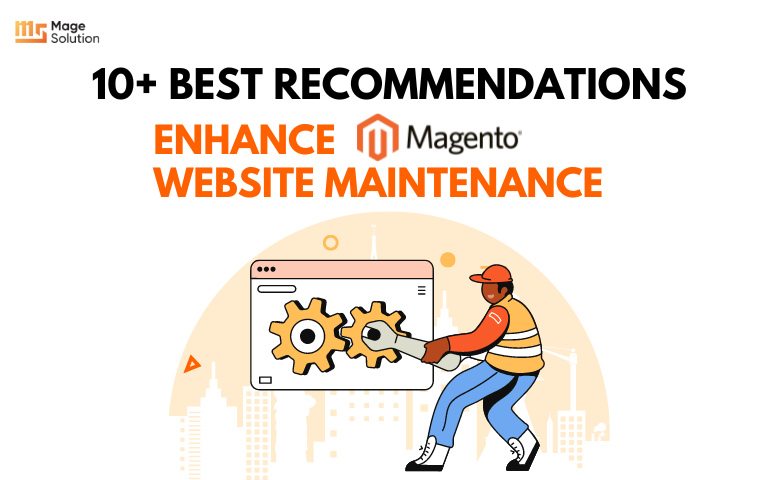Your cart is currently empty!
Magento performance: Powerful tips to improve it for your online store
Magento can be regarded as a robust, flexible, and the best performance-oriented alternative eCommerce. However, nothing is perfect. Similarly, Magento 2 still has several drawbacks, and the most noticeable one is the speed of Magento 2. Ensuring your eCommerce website is running fast is one of the most crucial elements to your sales, SEO rankings, abandonment rate, and the customer’s experience. Let’s get going to boost your Magento performance optimization!
Why Magento 2 is slow?
The Magento performance is not slow by default as the default store is powerful and runs smoothly. Actually, most slow interface and high loading times problems are due to misconduct as well as lack of knowledge in optimizing Magento performance. Once you can not meet the major requirements to run an e-store on Magento such as integrating unsuitable modules or do not enable the right extension, your website’s speed will certainly slow down. If you do not do something to handle these issues, your Magento store may lose a great number of potential shoppers because of your Magento slow speed. There are some reasons for Magento’s slow performance.
- Inappropriate Hosting
When the owner wants to minimize spendings on a Magento start-up. He is likely to select a server with default settings and low productivity. Unfortunately, these settings will not be suitable for Magento. Sometimes hosting platforms are not scalable enough to address the requirements as an eCommerce business grows. Therefore, the Magento site is hosted on a server with improper software and hardware.
- Abruptly Traffic Increase
When the website begins to create more sales and traffic, this issue is further escalated. Traffic growth might easily lead to a server crash if the server is not configured correctly. So the sales stop at all until the server is up again. The slow server during traffic peaks lead to an enormous increase in the bounce rate
- Too Many Extension
Because of too many unnecessary extensions installed in the improper server, Magento back-end turns out to be even slower than the front-end. It significantly increases the time spent to manage the website. Thus, you need to determine the extension you use most and remove the ones that turned out to be ineffective. To win the competition, your website should be powered with only proven and highly efficient Magento extensions.
How to improve Magento performance?

1. Check for the latest version
It is very crucial that you are always running the latest version of Magento as updates commonly including bug fixes and performance enhancement. There are three main ways to upgrade a Magento installation.
- Install a fresh version of the Magento file tree (the version you are trying to upgrade to).
- Run the installer from the file tree on top of the outdated database (thereby upgrading the database).
- Upgrade themes and custom extensions from the old version to the current version.
Upgrading Magento is a little harder than upgrading WooCommerce or Shopify. Magento also notifies you crucial updates in your notifications/messages inbox.
2. Optimize Javascript and CSS
Another reason which causes the slow speed of Magento 2 is Javascript and CSS. Follow the below guide to reducing the Javascript and CSS for speeding up Magento performance
At Admin panel, move to Store > Configuration > Advanced. Under the Advanced tab, click Developer. In the Javascript Settings section, change the values in three fields Merge JavaScript Files, Enable JavaScript Bundling, and Minify JavaScript Files to Yes. Then, change the fields Merge CSS Files and Minify CSS Files in the CSS Settings tab to Yes.
3. Enable Flat Categories and Products
One of the most typical reasons which impart your Magento performance is the database’s read speed. To resolve this issue, you can enable Flat Catalog. Here is the solution for you to do it:
Login your Magento 2 store’s admin panel. Then follow this Store > Configuration > Catalog. Then click on Catalog which is under the Catalog tab. For this step, you will see the Storefront section. When you have seen it, search two fields which are Use Flat Catalog Category and Use Flat Catalog Product, and change these fields to Yes.
4. Enable Varnish Cache
There are some ways that need to be implemented to improve Magento performance including the cache. See the below guide to enable Varnish Cache in order to for improving Magento performance
From the Admin panel, go to Store > Configuration > Advanced. Under the Advanced tab, click System, you will see the Full Page Cache section. In this section, you change the Caching Application field value from Built-in Cache to Varnish Caching.
5. Configure Memcached
Another useful way to improve Magento performance is by reducing the database load. The method to implement it is to configure Memcached which is a free and open-source distributed memory object caching system.
6. Use a lightweight theme and optimized images
- Use a lightweight theme as per your needs and taste.
- Use compressed images.
- Use PNG or SVG format for the logo.
- Use JPEG format for the product images.
7. Switch To Production Mode
Magento 2 can be managed from any of the three modes: default, developer, and production. The default and developer modes are utilized for debugging and never for the live site. However, the production mode is the fastest.
- Get the SSH details from your hosting provider to find out what mode your Magento website is using. Usse the below command:
php bin/magento deploy:mode:show - Run it once inside the root Magento folder.
- To turn the production mode, use the below command:
php bin/magento deploy:mode:set production
8. PHP accelerators
Utilizing a PHP accelerator is another way of caching. They help to enhance the performance of PHP scripts by caching them in their compiled state. You can use a PHP accelerator like APC, ZendOptimizer+ or Xcache.
- APC – http://pecl.php.net/package/APC
- Xcache – http://xcache.lighttpd.net
- eAccelerator – http://eaccelerator.ne
9. Content delivery network
Using a content delivery network (CDN) with Magento 2 is one of the easiest methods to immediately see decreased load times. In this way, you will make sure that you are serving your assets (product images, JavaScript, CSS) from multiple locations around the globe so they are delivered faster to your customers.
KeyCDN has a very easy [integration with Magento]/support/magento-cdn-integration) and Magento 2. Both can be set up with HTTP and HTTPS configurations
10. MySQL configuration
MySQL has its own “query cache” that it ulitized in Magento to help create dynamic pages and content while enhace performance. These are some suggestions settings for your my.cnf file:
query_cache_type = 1
query_cache_size = 32M
query_cache_limit = 2M
And also a recommended setting for php.ini:
php_value memory_limit 512M
11. Use fast-loading theme
A lightweight fast theme can help you improve Magento performance significantly.
12. Check website Performance Regularly
The website’s performance should be checked on a regular basis. This is an essential element because it helps you to find out what impact your web loading times and how new extensions or plug-ins perform, should be intergraded. There are numerous free performance monitoring tools available on the market such as GTMetrix, Pingdom, Uptrends
13. Fast web hosting
And last but not least, choosing a trustworthy and fast web hosting can be one of the most crucial elements to improve Magento performance and smooth user experience. You should stay away from cheap shared hosting as they tend to overcrowd their servers and you will end up sharing resources between hundreds of people. Read this post for more reference: Effective tips to choose the best hosting for Magento 2
Wrapping it Up
Speed is a dominant element in the success of an eCommerce store. A fast-loading Magento website responds quickly, converts better, and brings happiness to the customers, which naturally leads to a boost in sales and revenues. If you find any difficulties in the implementation of any of the above points, don’t hesitate to contact us. Check our Magento upgrade ervice to get the professional support! We — MageSolution offers tons of themes and extensions that can skyrocket your revenue and increase conversions.



